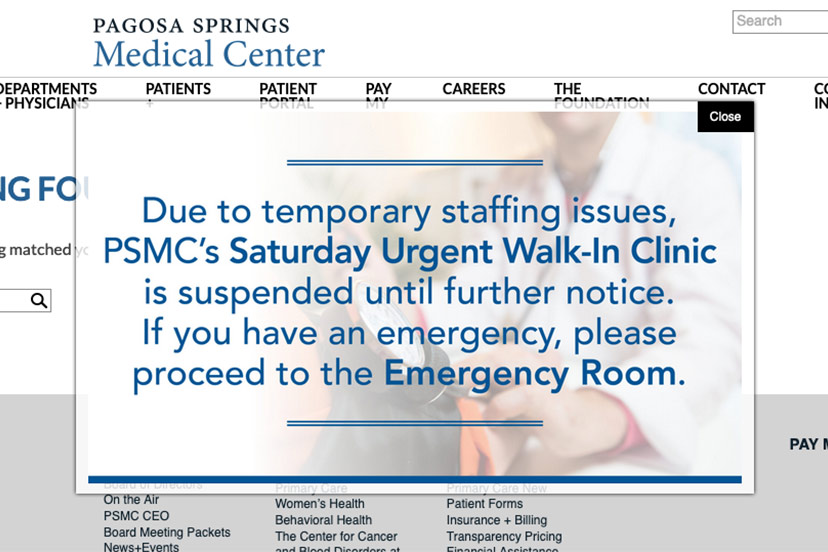As mentioned in Part One, residents of the Upper San Juan Health Services District — the tax-supported entity that operates the Pagosa Springs Medical Center — can expect to receive an ‘annual report’ in the mail soon, briefly highlighting some of PSMC’s recent accomplishments and plans for the future. You can view the document now, by visiting FlippingBook.com.
PSMC’s 2020 Community Report
This is one of two important documents the PSMC board and staff have been working on, but which were delayed by COVID. The other document is a ‘strategic plan.’ We were told that the community will be invited to give input on this draft document, although I’m not yet clear where suggestions should be submitted?
You can download the draft plan here.
USJHSD board president Greg Schulte and PSMC CEO Dr. Rhonda Webb gave a concise overview of the strategic plan at the Archuleta Board of County Commissioners work session on June 15.
Mr. Schulte:
“So where are we going? Like everyone else, there was a lot of work that we had to do with COVID. I don’t want to say we got ‘sidetracked’, but I guess that’s what happened…”
Dr. Webb:
“It’s hard to do a strategic plan in the middle of a pandemic, when you don’t know what’s going to happen with healthcare. Really, we do operate with tight margins, like all rural hospitals. We are independent, and it’s been our goal to stay independent. That’s what the people of this community want; that we’re not part of a big corporate entity… and with all of the growth we’ve had, there’s been a lot of expense with that. So we’re a young hospital, with a lot of debt and tight margins.”
Relatively speaking.
The Pagosa Daily Post has been in existence since 2004, slightly longer than the Pagosa Springs Medical Center, which opened its doors in 2008 under its previous name, Pagosa Mountain Hospital.
Unlike PSMC, the Daily Post has no strategic plan whatsoever, and has no plans to ever have a strategic plan. But of course, we’re not trying to balance a $40 million budget while operating in the healthcare industry’s ever-changing financial-regulatory-political environment. Nor are we trying to hire and retain 200-plus employees with varying levels of professional training… nor diagnose and treat dozens of individuals each day. Nor try and collect $500,000 worth of outstanding bills.
Dr. Webb:
“It’s an exciting time in Pagosa, to try and take it to the next level. We survived this pandemic and… I’m over that, like everybody. So always our focus is to have our patients and our customers be served, as the primary focus of everything we do…
“We want to address the medical, social and behavioral health needs. That’s really our job as a community hospital, and what we are being tasked to do by our governmental payers, Medicare and Medicaid. Just so people understand, Medicare pays us less than it costs us to provide care, and Medicaid pays us much less.”
The federal Medicare program reimburses PSMC — and other rural “Critical Access Hospitals” — at 99% of actual costs. That reimbursement rate will drop to 95% in January. About 45% of PSMC’s patients qualify for Medicare.
Medicaid, meanwhile, reimburses PSMC at about 60% of actual costs; about 18% of their patients are on Medicaid.
So it would appear that PSMC ‘loses money’ when treating nearly two-thirds of its patients. PSMC makes up the difference by offering higher priced treatments to non-Medicare, non-Medicaid patients. You might call them “profitable specialties.” Cancer treatment, as one example. Orthopedic surgery. Gastroenterology.
Dr. Webb:
“So it’s challenging to deal with that. Healthcare as a system — in terms of reimbursement — is sort of a broken system, for our country. And there are people working on how to change that.
“Next, we need to have [employees]. We struggle with the same issues everyone else does… having enough employees, and being able to pay employees enough to live in this area, is increasingly becoming more and more difficult. You hear that from everybody.
“Right now, we have 21 open positions at the hospital…”

Dr. Webb:
“We are, like everyone, reeling from the effects of last year. The hardest time was, I think, from March through May, and we applied for whatever [financial help] we could…”
That help included an application for a sizable Paycheck Protection Plan loan, which was — for certain businesses — forgivable. PSMC finally learned this June, a year later, that the loan would be forgiven.
Mr. Schulte:
“As Rhonda said, we operate on a very tight margin. The healthcare field is just very dynamic; it changes all the time. And so trying to plan for that, trying to offer as many services as we possibly can to the community, that make sense, while still being mindful that we have to bring in enough revenue to keep the doors open.
He addressed the three commissioners.
“And I saw you guys nodding your heads. Finding employees is such a huge problem for us. Obviously, we have some very specialized positions that need training, certifications, degrees, or whatever, and getting them to come here… and then they look at the housing market… and it’s tough. It’s really, really tough.”
County commissioner Warren Brown:
“I would just like to commend you, for all your work. This is a tremendous amount of work, even in a quasi-normal year.
“You know, being an anchor institution that you are for our community. People look for the quality of schools and the quality of health care when they make decisions. And if we are ever to diversify our economy here, we need to make sure that we have the quality institutions that will encourage folks to come here, and do that.”
“That” being, I assume, the diversification of the economy.
“That” being, I assume, getting off the tourism IV drip.

